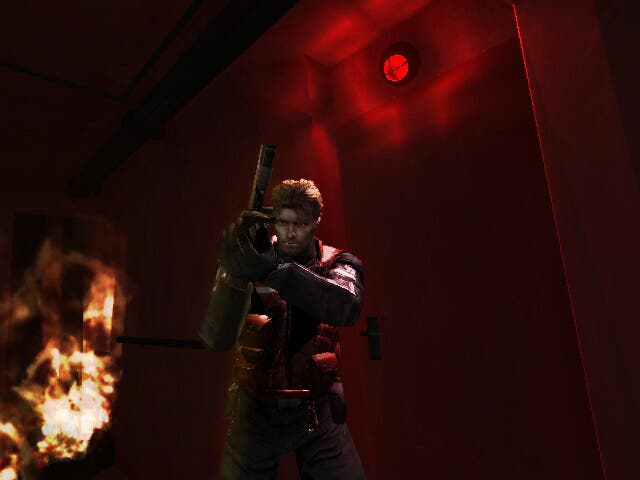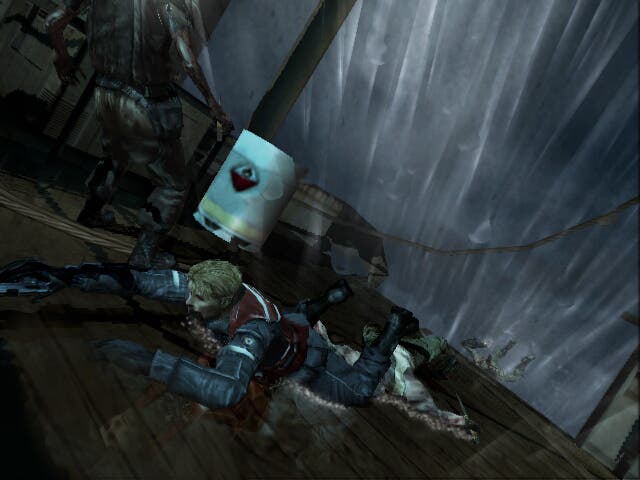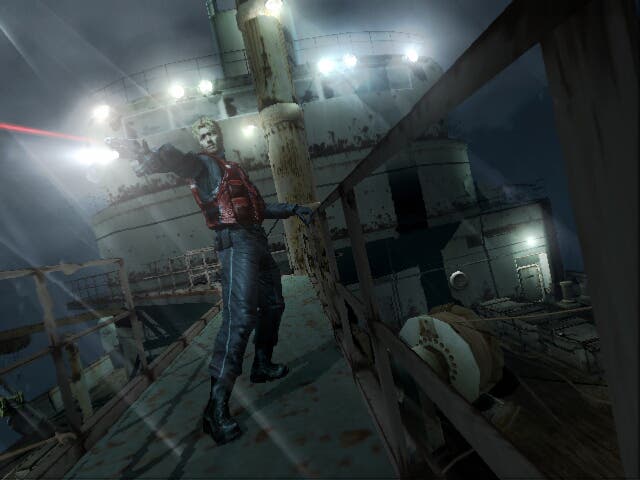Cold Fear
The horror of low expectations on high seas.
We're not sure why Western game developers seem to find it so tough to produce horror adventure games that can be talked of in the same breath as Resident Evil, Silent Hill and Project Zero, but it's one of those puzzling anomalies that's been going on for years now. The crazy thing is, the entire survival-horror genre was born in France in the early '90s with the seminal Alone In The Dark trilogy - a concept that a succession of Japanese developers have refined and made great strides with ever since.
Frustratingly, publisher Infogrames practically handed the likes of Capcom the survival-horror concept gift-wrapped by waiting fully six years to deliver the not-bad-but-not-nearly-good-enough Darkworks-developed sequel. Tragically, by the start of the noughties, few gamers knew of or cared about a new Alone In The Dark game. Instead of it being greeted like a returning hero, critics shrugged, the public looked the other way and it went down as a glorious missed opportunity.
Almost five years on, Darkworks, meanwhile, has somehow managed to tough it out, and signed up with fellow Frenchmen Ubisoft to re-emerge with a grim and grisly survival-horror title by the name of Cold Fear; a windswept, rain-lashed tale of US Coast Guard Tom Hansen's attempts to uncover the mysterious goings-on aboard a stricken Russian Whaler in the Bering Sea.
Storm bringer

Cold Fear kicks off in promising fashion, luring players into a storm-ravaged marine environment that has you dodging crashing waves one minute, swinging cargo the next, while the violent swell of the sea threatens to drag you of the side of the ship into the raging torrent if you're not careful. The first few minutes you'll spend just lurching around, desperately trying to get your sea legs, squinting through the sea spray and lashing rain and admiring one of the most convincingly oppressive gaming environments yet. But it doesn't last.
Once you've got your bearings and manage to suss out how to get inside the vessel, the game quickly settles on traditional territory: a sense of dark foreboding, destroyed cabins, corridors, locked doors, more locked doors, random objects, ammo clips, health packs, things that leap out on you. You know the drill.
In a game that wears its Alien/The Thing influences on its sleeve, it's no surprise to learn (via the usual discarded diary pages and letters) that one of those oh-so-dastardly secret experiments has been going on, and that almost everyone on board has turned into cleaver-wielding zombies with glowing red eyes. Even less surprising is when you learn that parasitic, tentacled creatures called Exocels are prowling the ship, capable of crawling on the ceiling, dropping down and crawling into the mouths of their accommodating hosts.
Thus kicks off a game positively chock full of opportunities to do battle with said respawning creatures of death, while attempting to go about your business of reuniting keys and key codes with their respective doors, while scooping up the liberally placed health and ammo packs. You could say that Darkworks were comfortable with sticking to well worn game mechanics.
Reanimator

No surprise, then, that the over-the-shoulder view used with such success in Resident Evil 4 has been replicated here, complete with laser sight for added accuracy when you're trying to pull off vital headshots to send these perpetually reanimating goons back to their respawning maker. As such, you'll spend a good deal of your time in Cold Fear trying manfully to get a decent shot on target, but in the absence of a lock-on it's something of a lottery that usually results in taking down your subject but not actually killing them. Most of the time, you're faced with a frantic race to stamp on their head before they get up and carry on ripping chunks out of you, but even that tends to be fraught with error.
Given that a lot of the combat in Cold Fear takes place in corridors, and given that the game maps the 'open door' button to the same button required for stomping zombie face, you quite often find yourself accidentally entering another room rather than squishing skull. More annoying still is to return into the room you've just accidentally exited to be instantly attacked by the same zombie you've just emptied your gun into, which not only wastes a load more ammo but probably a chunk of health into the bargain. Genius.
So, if you're not annoyed enough by minor quirks like that, or the overt darkness of a game that forces you to have your gun drawn (and therefore holding down the left trigger for hours on end) to be able to shine your torch beam around, or a game that regularly disorientates the player by switching the camera perspective around as soon as you let go of the over-the-shoulder view (usually right in the middle of trying to stomp on a zombie head), then you'll love the fact that there's absolutely no map facility. Wonderful.
Although Cold Fear is a pretty straightforward 8-10 hour game, we promise that at least half of that will be spend wandering around lost trying to find your way to your next port of call. As any survival horror aficionado will tell you, trying to memorise layouts is hard enough at the best of times, never mind when most of it looks the same and the camera perspective keeps switching, giving you no chance of really getting a grip on what's where. Cold Fear then defecates on your progress by introducing one way doors which force you to take massive detours via more respawning zombie death machines. Great.
Captain Sensible

And if that wasn't retarded enough, one particular puzzle near the end of the first half of the game has you looking for the Captain's Quarter (having just found the key), but then manages to design it as a location with two entrances - only one of which your key will work in. More confused wandering later and you'll find it, but not before you've shouted at alarming decibel levels at the game designers for managing to dream up all-new ways to irritate the gamer. If you then happen to somehow fall victim to the game's prescribed save system, you'll probably wonder why you're bothering at all; it just feels designed to hold the gamer up for the sake of it.
Later, when the game's setting moves onto a similarly-stricken oilrig, the same overall principles endure, but by then you've long since realised that the game's initial promise has dissipated into an extended jaunt around a zombie-filled playground in what are - in the main - fairly humdrum environments. In typical fashion, the ante is upped, the enemy count increases, the weapons get better and more powerful (the flame thrower and grenade launcher two such examples), but no matter what the game throws at you from then on, it never becomes more interesting for it.
If the story was well scripted, with great characters that were convincingly acted and somehow compelling, we'd probably forgive many of the minor issues, but everything about the whole affair is so horribly predictable and feels done to death. And beyond. Again, if the creatures weren't so generic in terms of how they look and how they behave it might be a different story. For a game that gradually becomes so combat-centric, you'd think Darkworks would have infused the whole thing with convincing unpredictability to keep you on your toes, but the truth is that you know exactly what each of the creatures are going to do. The only thing that ever holds you back is the unwieldy control system and the game's irritating tendency to inconsistently repopulate previously cleared areas. Other than that it's the kind of sub-par action that you wouldn't put up with in any other game.
Cold reality
You can see that Darkworks had a great basic idea but never really got to run with it beyond the game's opening scenes. After the novelty of the atmospheric opening rain-lashed storm scene wears off what are you left with? Half-destroyed cabins in the dark, cold rooms with strung up corpses, generic corridors with the same consistently reappearing zombies and Exocels springing up to annoy the hell out of you? The predator-style creature that appears in the second half might be deadly and scary, but then becomes so awkward to fight you may as well just run away. The further we got into Cold Fear the less we cared, and that's a sad reflection on a game we were initially impressed with for its atmospheric attention to detail.
The whole thing just feels a bit half-baked, with moody but unimaginative environments, done-to-death one-dimensional characters, exceptionally tired gameplay mechanics that favours basic A-to-B object collection rather than injecting anything even vaguely resembling a puzzle and a combat system that's at best functional, and at worst unhelpful. There are many vastly superior survival-horror games out there in the market, and although Cold Fear isn't a bad game by any stretch of the imagination, there are too many annoyances and there's too little inspiration to recommend that anyone but adventure completists give it the time of day. Yet again we're staring down the barrel of another well meaning but ultimately lacklustre effort to revive the Western survival-horror scene.

